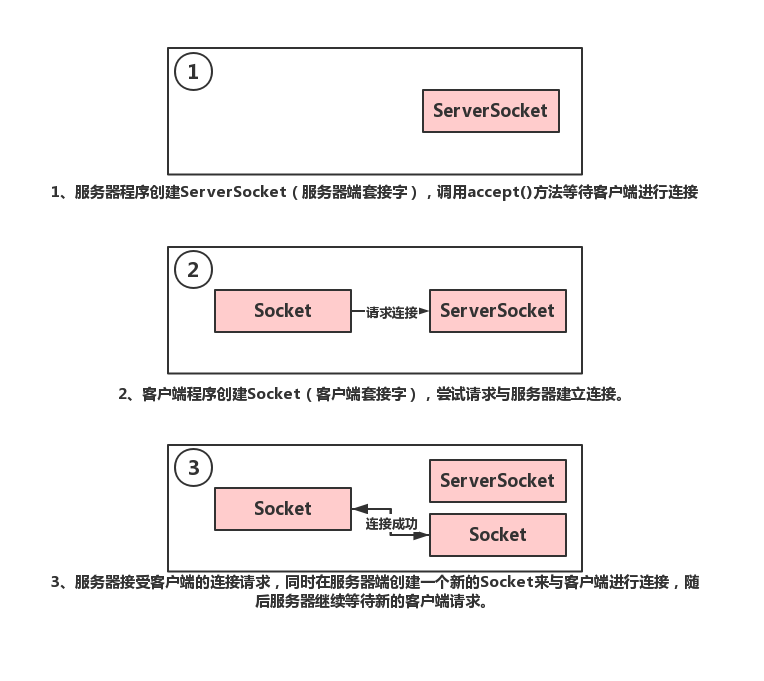Vue如何實(shí)現(xiàn)組件間通信
最常見(jiàn)的就是父子之間的通信,通信是雙向的數(shù)據(jù)傳遞。
1.1 父組件 --> 兒子組件父組件向兒子組件傳遞數(shù)據(jù)的方式就是 通過(guò) Prop 向子組件傳遞數(shù)據(jù)。
//child.vue<template> <div>我是兒子,我收到來(lái)自父親的數(shù)據(jù)為 {{value}} </div></template><script>export default { props:{value: String }}
//App.vue<template> <div id='app'> <Child :value='x' /> </div></template><script>import Child from ’./components/Child’export default { data(){ return { x: ’hi,child’ } }, components:{ Child }}</script>1.2 兒子組件 --> 父組件
兒子組件向父組件傳遞數(shù)據(jù)的方式就是通過(guò)子組件內(nèi) $emit 觸發(fā)自定義事件,子組件使用時(shí) v-on 綁定監(jiān)聽(tīng)自定義事件。
這里的 v-on 事件通信是在子組件使用時(shí)作為子組件的事件屬性自動(dòng)進(jìn)行監(jiān)聽(tīng)的。
因此兒子組件向父組件傳遞數(shù)據(jù),依賴于子組件使用時(shí)的自定義事件屬性。
//child.vue<template> <div>我是兒子,我收到來(lái)自父親的數(shù)據(jù)為 {{value}}<button @click='sayHi'> 向父組件打招呼</button> </div></template><script>export default { props:{value: String }, methods:{sayHi(){ this.$emit(’sayHi’,’hi,parent!’);} }}</script>
//App.vue<template> <div id='app'> 我是父組件,我收到子組件傳來(lái)的數(shù)據(jù)為 {{y}} <Child :value='x' @sayHi='y = $event'/> </div></template><script>import Child from ’./components/Child’export default { data(){ return { x: ’hi,child’, y: ’’ } }, components:{ Child }}</script>

爺孫間通信,可以使用兩次 v-on 通信,爺爺爸爸通信,然后爸爸兒子通信。
也可使用下方的任意組件間通信的方式。
3. 任意組件間通信任意組件間通信就不再區(qū)分是 A 向 B 通信,還是 B 向 A 通信,而是通用的方式,誰(shuí)想發(fā)送數(shù)據(jù)就使用對(duì)應(yīng)的 API 發(fā)送數(shù)據(jù),誰(shuí)想要接收什么數(shù)據(jù),就使用對(duì)應(yīng)的 API 接收。
任意組件間通信有兩種方式,一種是使用 EventBus 發(fā)布訂閱模式通信,一種是使用 Vuex 通信。
3.1 EventBusEventBus ,從字面意思理解就是事件公交車(chē),所有觸發(fā)的事件傳遞的數(shù)據(jù)都從前門(mén)上車(chē)保存到公交車(chē)上,然后通過(guò)監(jiān)聽(tīng)對(duì)應(yīng)事件提供的出口讓對(duì)應(yīng)的事件數(shù)據(jù)下車(chē)。
EventBus,實(shí)際意思是發(fā)布和訂閱模式,就是誰(shuí)想把數(shù)據(jù)傳遞出去,就要通過(guò)觸發(fā)自定義事件的 API 進(jìn)行數(shù)據(jù)的發(fā)布;誰(shuí)需要接收該數(shù)據(jù)信息的,就通過(guò)事件監(jiān)聽(tīng)的 API 進(jìn)行數(shù)據(jù)的監(jiān)聽(tīng),一旦檢測(cè)到監(jiān)聽(tīng)的數(shù)據(jù)發(fā)布出來(lái),就會(huì)接收,這就是數(shù)據(jù)的訂閱。
EventBus 通信方式最重要是搞明白發(fā)布和訂閱的接口 API,在 Vue 中,Vue 實(shí)例有提供兩個(gè)接口,即 $emit 和 $on ,因此可以新創(chuàng)建一個(gè)空的 Vue 實(shí)例,來(lái)獲得這兩個(gè)接口。
const eventBus = new Vue();eventBus.$emit(eventName, […args]) //發(fā)布事件eventBus.$on(event, callback) //訂閱事件
實(shí)例如下:
// eventBus.jsimport Vue from ’vue’export const eventBus = new Vue();
//child<template> <div>我是兒子,我收到來(lái)自父親的數(shù)據(jù)為 <strong>{{value}}</strong><button @click='sayHi'> 向父組件打招呼</button><button @click='sibling'> 向兄弟組件打招呼</button> </div></template><script>import {eventBus} from ’../eventBus.js’export default { props:{value: String }, methods:{sayHi(){ this.$emit(’sayHi’,’hi,parent!’);},sibling(){ eventBus.$emit(’sibling’,’hi,brother’);} }}</script><style scoped> strong{color: red; }</style>
//sibling<template> <div>我是兄弟組件,我收到來(lái)自兒子組件的數(shù)據(jù)信息為 <strong>{{x}}</strong> </div></template><script>import {eventBus} from ’../eventBus.js’export default { data(){return { x: ’’} }, mounted(){eventBus.$on(’sibling’, (msg)=>{ this.x = msg;}) }}</script><style scoped> strong{ color: green; }</style>
//parent<template> <div id='app'> 我是父組件,我收到子組件傳來(lái)的數(shù)據(jù)為 <strong>{{y}}</strong> <Child :value='x' @sayHi='y = $event'/> <Sibling></Sibling> </div></template><script>import Child from ’./components/Child’import Sibling from ’./components/Sibling’export default { data(){ return { x: ’hi,child’, y: ’’ } }, components:{ Child, Sibling }}</script><style scoped> strong{ color: blue; }</style>

關(guān)于 EventBus 這部分,可能存在這樣一個(gè)疑問(wèn),既然 Vue 實(shí)例中都有 $emit 和 $on,為什么不直接用 this.$emit 觸發(fā)事件, this.$on 接收事件呢?還非得要額外一個(gè)空實(shí)例 eventBus = new Vue() 。那是因?yàn)椋琕ue 中每個(gè)組件都是一個(gè)單獨(dú)的 Vue 實(shí)例,你在這個(gè) Vue 實(shí)例中觸發(fā)該實(shí)例的 emit 事件,另外一個(gè)實(shí)例的 on 事件是接收不到的,不在一輛公交車(chē)上,怎么能進(jìn)行事件通信呢?因此就必須要一個(gè)公共的公交車(chē),也就是事件總線。
上述實(shí)例中的 eventBus 的使用方法是局部的 eventBus,誰(shuí)要用到 eventBus 要自己手動(dòng)引入。也可以將 eventBus 做成全局的,比如掛在 vue 的原型上。
//main.jsimport Vue from ’vue’import App from ’./App.vue’Vue.config.productionTip = falseVue.prototype.$eventBus = new Vue();//添加這句,一定要在下方的 new Vue 前。new Vue({ render: h => h(App),}).$mount(’#app’)
//childsibling(){ this.$eventBus.$emit(’sibling’,’hi,brother’);}
//siblingmounted(){ this.$eventBus.$on(’sibling’, (msg)=>{this.x = msg; })}
除了上述的添加屬性到 Vue 原型的方式外,還可以使用 Object.defineProperty() 為 Vue 原型添加屬性。
import Vue from ’vue’import App from ’./App.vue’Vue.config.productionTip = falselet eventBus = new Vue()Object.defineProperty(Vue.prototype,’$eventBus’,{ get(){ return eventBus }})new Vue({ render: h => h(App),}).$mount(’#app’)3.2 Vuex
Vue 組件間的通信也可使用專(zhuān)門(mén)為 vue.js 應(yīng)用程序開(kāi)發(fā)的狀態(tài)管理模式:Vuex。Vuex 的使用比較復(fù)雜,詳細(xì)可見(jiàn) Vuex 博客。Vuex 適用于大型的復(fù)雜的 Vue 項(xiàng)目的狀態(tài)管理。對(duì)于一些中小型的應(yīng)用程序,可以根據(jù) Vuex 的原理自定義 store 模式進(jìn)行狀態(tài)管理,vue 自定義狀態(tài)管理,可詳見(jiàn) Vue 簡(jiǎn)單狀態(tài)管理—store模式 博客。
無(wú)論是 Vuex 還是 自定義 store模式 ,其實(shí)現(xiàn)組件間通信的原理都是通過(guò)共享數(shù)據(jù)的方式實(shí)現(xiàn)的。組件間使用相同的數(shù)據(jù)源,當(dāng)一個(gè)組件改變數(shù)據(jù)時(shí),另一個(gè)組件依賴的數(shù)據(jù)源也就改變了。
以上就是Vue如何實(shí)現(xiàn)組件間通信的詳細(xì)內(nèi)容,更多關(guān)于Vue組件間通信的資料請(qǐng)關(guān)注好吧啦網(wǎng)其它相關(guān)文章!
相關(guān)文章:
1. idea設(shè)置提示不區(qū)分大小寫(xiě)的方法2. 使用AJAX(包含正則表達(dá)式)驗(yàn)證用戶登錄的步驟3. Java PreparedStatement用法詳解4. Java實(shí)現(xiàn)的迷宮游戲5. django queryset相加和篩選教程6. IDEA 2020.1.2 安裝教程附破解教程詳解7. Java利用TCP協(xié)議實(shí)現(xiàn)客戶端與服務(wù)器通信(附通信源碼)8. JS圖片懶加載庫(kù)VueLazyLoad詳解9. 利用ajax+php實(shí)現(xiàn)商品價(jià)格計(jì)算10. Spring如何集成ibatis項(xiàng)目并實(shí)現(xiàn)dao層基類(lèi)封裝

 網(wǎng)公網(wǎng)安備
網(wǎng)公網(wǎng)安備